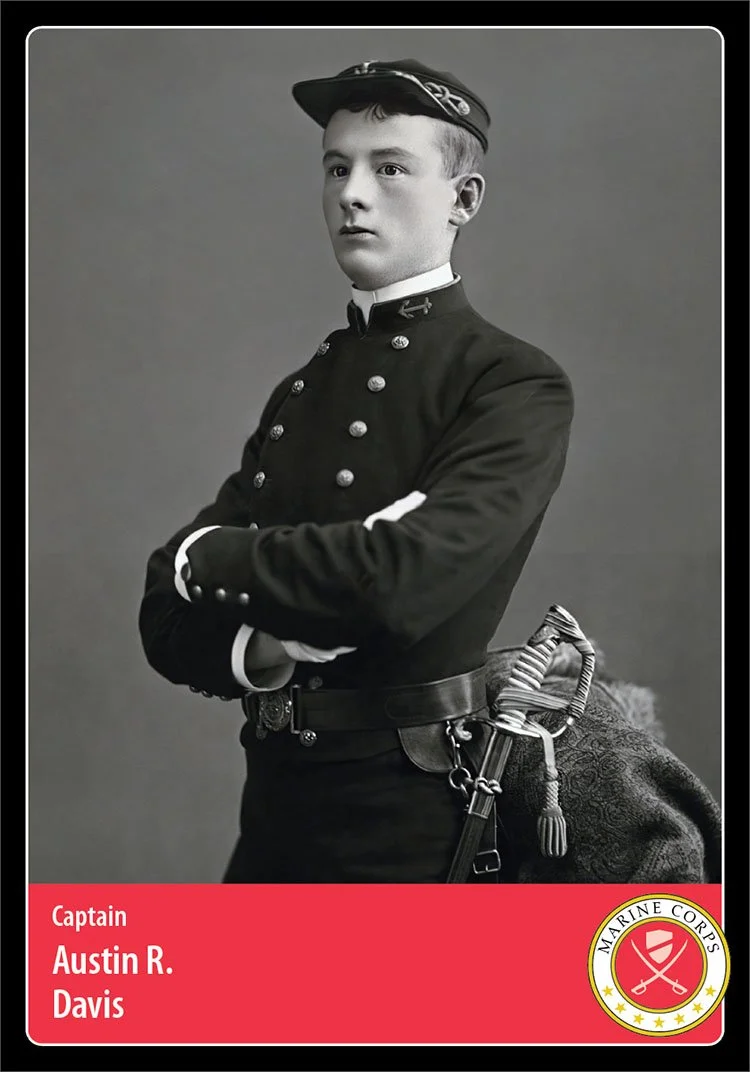Hero Card 91, Card Pack 8
Photo: United States Naval Academy, Nimitz Library
Hometown: Atlanta, GA
Branch: U.S. Marine Corps
Unit: USS Oregon (BB-3)
Date of Sacrifice: July 13, 1900 - KIA in Tientsin (now Tianjin), China
Age: 28
Conflict: Boxer Rebellion, 1899-1901
At the age of 17, Georgia native Austin Rockwell Davis was admitted to the United States Naval Academy at Annapolis, Maryland on May 21, 1888. By 1893, Davis served as a Naval Cadet aboard the USS Kearsarge. He enlisted in the United States Marine Corps as a Second Lieutenant on July 1, 1894, and was assigned to Marine Barracks in Washington, D.C.
In 1895, the Cuban people were struggling for independence from Spain’s colonial rule, and Spain responded with brutal measures to put down the rebellion. Cuban rebels appealed to the United States for intervention.
With conflict brewing, the American government sent the battleship USS Maine to Cuba’s Havana harbor to protect U.S. citizens and property after rioting broke out in the city. On February 15, 1898, a massive explosion on the Maine killed 260 American crew members aboard. Whether the explosion was caused by a Spanish mine or an on-board accident is unknown. But the incident—combined with Spain’s brutal suppression of the Cuban people—led to the outbreak of the Spanish-American War in April, 1898.
Second Lieutenant Austin Davis served aboard the battleship USS Oregon in San Francisco, California. Following the explosion of the Maine in Havana harbor, the Oregon was ordered to make the voyage around South America to support the Atlantic fleet. Its harrowing journey through harsh gales in the Straights of Magellan took 66 days to complete. The trip was a prime example of the danger and time delays required to move U.S. naval assets between the two oceans during emergencies—and added to the argument for the construction of the Panama Canal in 1904.
The Oregon arrived in time to fight in the Battle of Santiago (Cuba) on July 3, 1898. Second Lieutenant Davis was given command of a crew assigned to take charge of the surrendered Spanish cruiser ship Cristóbal Colón. The Spanish-American War lasted only a few months, from April to December 1898, and marked the end of Spanish colonial rule not only in Cuba but throughout Latin America and the western Pacific.
Davis was promoted to First Lieutenant in June 1898. That year, after an October refitting in a New York Navy Yard, the Oregon was sent to the American Naval Base Cavite in Manila, the Philippines. The ship performed blockade duty in Manila Bay in support of the Army during a Philippine insurrection.
Another promotion for Davis came on March 3, 1899, when he earned the rank of Captain.
In June 1900, the Oregon was called into service to help quell China’s “Boxer Rebellion.” Japanese, European, and American governments were exercising increasing economic control over China’s larger cities and railroads. The walled port city of Tientsin (now Tianjin) was just south of Peking (now Beijing), China’s capital city and center of power. Tientsin’s harbor was a key transport hub for goods being moved to and from China and markets worldwide.
Animosity and rejection of the growing foreign influence grew into attacks on railroads, churches, and Christian missionaries. The Boxers—Chinese nationals who practiced martial arts, which Westerners referred to as “shadow boxing”—increased their attacks on Western diplomatic districts and Chinese nationals who cooperated with the foreigners.
In June 1900, a contingency of 20,000 American, Austro-Hungarian, British, French, German, Italian, Japanese and Russian troops moved into China to quell the rebellion in Tientsin. While the city was taken by international forces within weeks, the victory came at a high cost.
Estimates vary, but the conflict likely cost up to 100,000 lives. Among them was Captain Austin R. Davis, who was struck while positioned in a forward trench about eight miles from Tientsin on July 13, 1900. Col. Robert Meade gave this account in his report about the incident:
I regret to report the death of Capt. A.R. Davis, who was killed at my side in the advanced trench. He was killed almost instantly. I had his body brought in with the wounded, and he is buried here in Tientsin, his grave being marked. This was all I could do.
Temporarily buried near the scene of his death, Davis was moved to Arlington National Cemetery, across the Potomac River from Washington, D.C., and honored in a ceremony on May 22, 1901. His monument in Section 1 Site 38C was erected by officers of the United States Marine Corps. He was 28 years old.
Sources
Photo: United States Naval Academy, Nimitz Library
Naval History and Heritage Command: Oregon II (Battleship No. 3) 1896-1942
History.com: Spanish-American War
U.S. Naval Academy Virtual Memorial Hall: Austin R. Davis, Capt, USMC
Arlington National Cemetery: Austin R. Davis – Captain, United States Marine Corps
The Atlanta Constitution, May 22,1901: Arlington to Receive Body of Austin Davis
The Richmond News Leader, July 17, 1900: Defeat at Tien Tsin
History.com: Boxer Rebellion
Burial Site: Find a Grave





